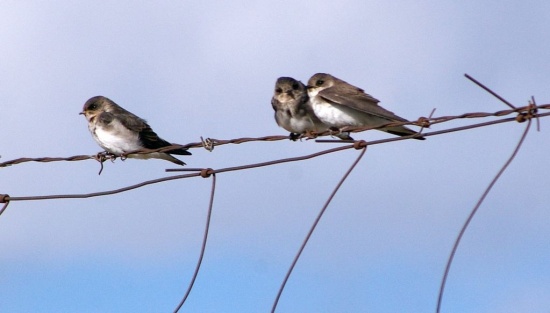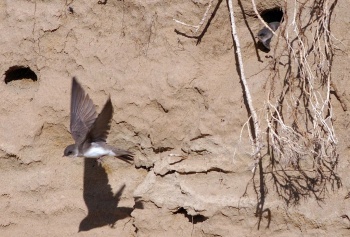Alternative name: Pale Sand Martin
- Riparia diluta
Identification
12 cm (4¾ in)
- Pale greyish-brown upperparts
- Darker brown remiges and rectrices
- Whitish underparts
- Pale brown breast band
- Shallowly forked tail
Distribution
India and central and eastern Asia.
Taxonomy
This species was recently split from Sand Martin.
Subspecies
There are six subspecies[1]:
- R. d. diluta:
- Breeds from Kazakhstan south to Uzbekistan and western Tajikistan, east through Siberia to the Lena River and northeastern China; winters in South Asia
- R. d. indica:
- R. d. fohkienensis:
- Central and eastern China
- R. d. tibetana:
- South-west China (Xizang-Qinghai plateau)
Habitat
Open country, usually near water, in areas of sympatry with Sand Martin.
Behaviour
Diet
Their diet is not fully know, presumably insects caught in flight. The are usually seen feeding in groups and often with other hirundine and swift species.
Breeding
They breed in colonies. The nest is at the end of a burrow in a bank.
References
- Clements, J. F., P. C. Rasmussen, T. S. Schulenberg, M. J. Iliff, T. A. Fredericks, J. A. Gerbracht, D. Lepage, A. Spencer, S. M. Billerman, B. L. Sullivan, and C. L. Wood. 2023. The eBird/Clements checklist of Birds of the World: v2023. Downloaded from https://www.birds.cornell.edu/clementschecklist/download/
- Gill, F, D Donsker, and P Rasmussen (Eds). 2024. IOC World Bird List (v 14.2). Doi 10.14344/IOC.ML.14.2. http://www.worldbirdnames.org/
- Handbook of the Birds of the World Alive (retrieved September 2016)
Recommended Citation
- BirdForum Opus contributors. (2025) Pale Martin. In: BirdForum, the forum for wild birds and birding. Retrieved 13 March 2025 from https://www.birdforum.net/opus/Pale_Martin
External Links
GSearch checked for 2020 platform.1





